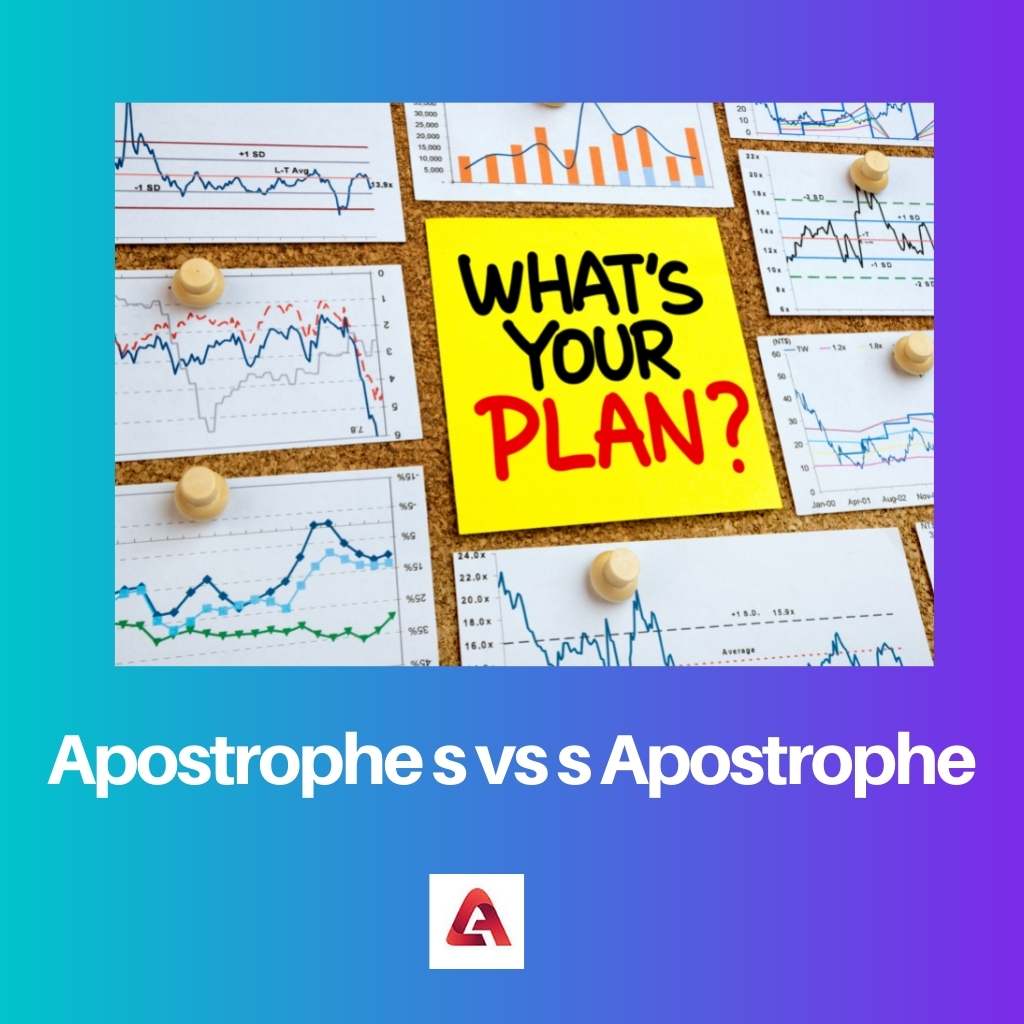It is needless to say that learning a language takes immense dedication and an eye for detail. But English is a language that confuses even the most fluent speaker.
Key Takeaways
- The apostrophe ‘s’ is used for singular or plural nouns not ending in ‘s’ to show possession, such as “the dog’s toy” or “the children’s playground.”
- The s’ apostrophe is used for plural nouns ending in ‘s’ to indicate possession, such as “the dogs’ toys” or “the teachers’ lounge.”
- Both forms are crucial for demonstrating possession in English but must be used correctly to ensure everything is clear.
Apostrophe s vs s Apostrophe
The difference between Apostrophe s and s Apostrophe is that while the former is used when we wish to convey an individual’s possession of a certain thing or quality, as against the latter’s usage, which is to convey that the possession of a thing or quality not by an individual but by more than one person.

Apostrophe s is used in the context of a possessive now, demonstrating the person’s ownership over a certain thing or quality.
S Apostrophe is used in the form of a possessive noun to convey ownership as well, but it differs from the former in a crucial aspect. It is used when the possession or ownership of something or quality by more than one person is to be conveyed.
Comparison Table
| Parameters of Comparison | Apostrophe s | s Apostrophe |
|---|---|---|
| Usage | It is when conveying an individual’s possession of a certain thing or quality. | It is used to convey that more than one person possesses a thing or quality. |
| Compound Possessive | If two nouns are acting separately, the apostrophe has to be placed after each noun. | There is no scope for it here. |
| S/SS | It has no applicability here. | When a person’s name or a noun ends in ‘s’, this should be used to give clarity. |
| Exceptions | In the case of an irregular plural noun, this should be used. | There are no exceptions in this regard. |
| Example | Sonya’s house is grand and beautiful. | The Smiths’ have a party at their place tonight. Thomas’ books were stolen right before his exams. |
What is Apostrophe s?
An apostrophe s is used in the context of a possessive now, demonstrating the person’s ownership over a certain thing or quality.
Using an apostrophe before ‘s’ is so simple that this shouldn’t confuse one at all. Our subject of focus should be whether the noun in question is singular or plural.
There is common confusion about whether an apostrophe can be used before ‘s’ if a person’s name ends in S. This is hotly debated because some sources state that it is not mandatory to use an apostrophe before ‘s’ in this case, and the apostrophe should be used after ‘s.’

What is s Apostrophe?
S Apostrophe is used in the form of a possessive noun to convey ownership as well, but it differs from the former in a crucial aspect. It is used when the possession or ownership of something or quality by more than one person is to be conveyed.
It is pertinent to note that in this regard, the apostrophe is always placed before the ‘s’ instead of after it.
There is common confusion about whether an apostrophe can be used before ‘s’ if a person’s name ends in S. This is hotly debated because some sources state that it is not mandatory to use an apostrophe before ‘s’ in this case, and the apostrophe should be used after ‘s’.
Main Differences Between Apostrophe s and s Apostrophe
- In the case of an irregular plural noun, Apostrophe s has to be used. In contrast, s Apostrophe has no role to play in this context.
- An example with Apostrophe s in it is- Sonya’s house is grand and beautiful. On the other hand, an example with s Apostrophe is- The Smiths’ have a party at their place tonight.

- https://www.proquest.com/openview/2411acd771726546179677ee3f18bea9/1?pq-origsite=gscholar&cbl=18750&diss=y
- https://www.cambridge.org/core/journals/english-today/article/abs/apostrophes-who-needs-them/7F58D7F5D133D1E99C4C6B332CB18E18

I find this post overly pedantic. It would be more engaging with less complex language.
Hmm, I don’t mind the complexity – it’s refreshing to see such in-depth content for once.
Agreed, this could be simplified to cater to a wider audience.
This is a brilliant and insightful guide. I am grateful for the level of detail in the explanations.
The examples provided serve their purpose, but I feel there was room for more detail in that section.
This is the most comprehensive explanation of apostrophes I have ever come across.
This is a great guide for distinguishing between apostrophes. It’s very informative.
What a well-detailed explanation!
I’ve learnt so much from this. Thanks for making it clear!
This apstrophe explanation is quite ambiguous and leaves room for confusion. More concrete examples would help.
I don’t see it as confusing at all, but I acknowledge that more examples might help.
I agree, the examples could be more illustrative.
Such a dry topic, but surprisingly it’s been delivered in an engaging manner.
It’s a breath of fresh air to read something so insightful about such a dull topic.
I know what you mean, it’s not the most riveting subject but this was surprisingly captivating.
This guide is severely lacking humor. It could use a touch of light-heartedness to brighten it up.
It might benefit from a bit of light humor, I see where you’re coming from.
I quite like the serious tone. It’s a breath of fresh air from all the forced humor you come across.